Most people (me having been one of them) don’t know what the Sacred Valley is and think Machu Picchu is an isolated city hidden in the Andes of Peru.
In actuality Machu Picchu is just one of the many sites that the Incas built from 1438 to 1533, when the Spanish conquest led by Francisco Pizarro destroyed this magnificent civilization.
 I’d spoken before about the Inca Empire, how technologically advanced they were and how they spread out from the south of Colombia down to Chile, including Ecuador, Peru and Bolivia.
I’d spoken before about the Inca Empire, how technologically advanced they were and how they spread out from the south of Colombia down to Chile, including Ecuador, Peru and Bolivia.
The Inca Empire was actually a collection of civilizations that were ruled by The Inca from the region of Cusco in today’s Peru.
What is the Sacred Valley?
The Sacred Valley is a river valley near Cusco, formed by the Urubamba River. It includes everything between Calca and Cusco, Piquillaqta and Ollantaytambo.
This was the epicenter of the Inca culture, one of the most important of pre-columbian (before Christopher Columbus) civilizations.
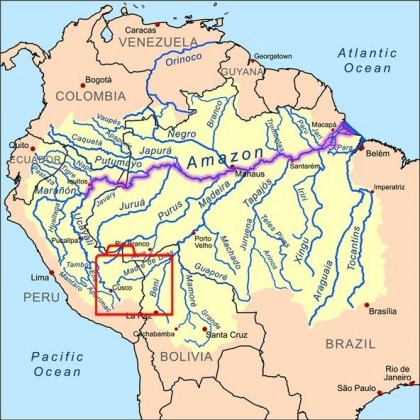
Sacred Valley, Cusco, Peru, South America. Photo: geluty.over-blog.com
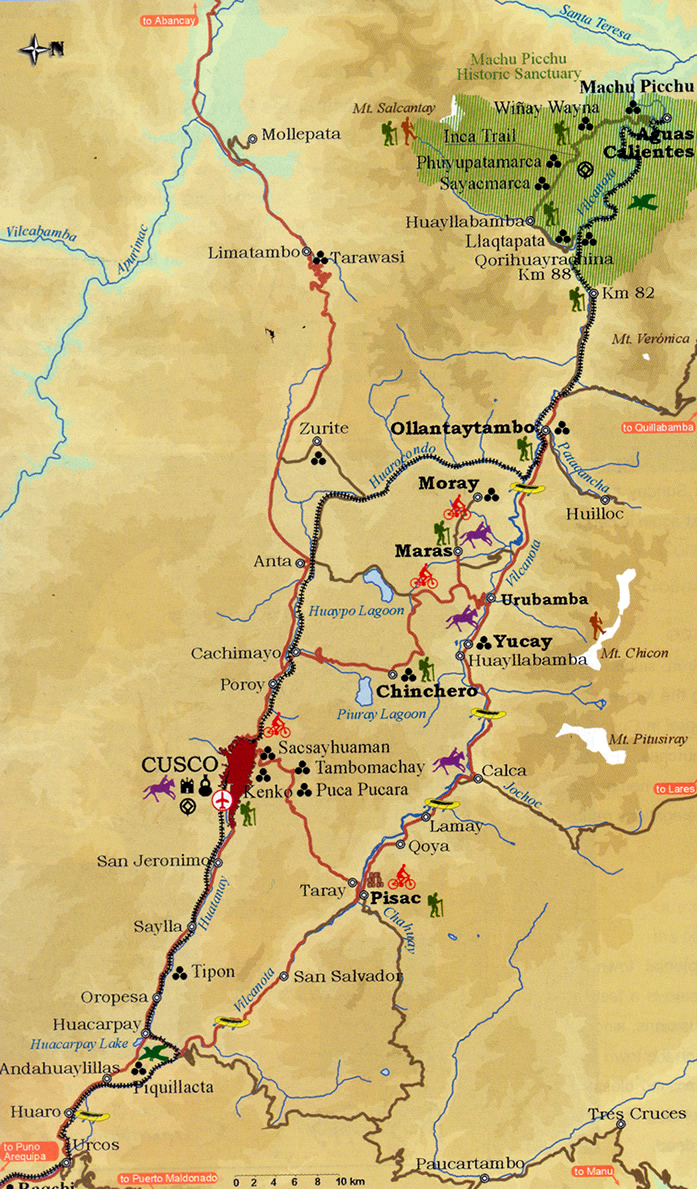
Sacred Valley map. Photo: perudiscover.com
Why is the Sacred Valley important?
If you go to Peru to visit Machu Picchu and only Machu Picchu, you’re missing half the story. Machu Picchu was the main city, hidden between the mountains of the Andes, safe from conquest.
But there is so much more than that.
Machu Picchu was only found in the beginning of the 20th century, so it was never raided or attacked by the Spanish conquistadores.
However, there are several Inca settlements of great importance inside the Sacred Valley that provide a more holistic view of what the Inca civilization was about.
How big and magnificent their building campaigns were, how much they respected and communicated with nature.
How in such little time (less than 100 years) they became the dominating force in South America during the 15th and 16th centuries.
Transportation
Knowing how to get from one place to another is key when visiting Machu Picchu and the Sacred Valley.
The regular way of getting to Machu Picchu is as follows.
- Taxi from your hotel to the train station. (About 5 to 10 minutes if you’re staying in Cusco).
- Train ride from Cusco to Aguas Calientes. (About 4:30 hours).
- Bus ride from Aguas Calientes to the skirts of the mountain. (About 30 minutes).
- A steep hike up the mountain, to finally get that overwhelming general view of Machu Picchu below (From 15 to 30 minutes depending on how fit you are).
Your visit to Machu Picchu takes one day.
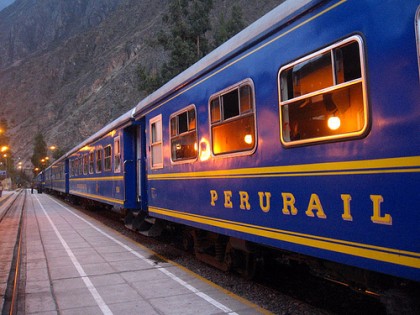
PeruRail. Photo: www.tvperu.gob.pe
As for the Sacred Valley just ask your hotel concierge to arrange a private car for you. It can be a bit expensive, but the experience is well worth it.
Your visit to the Sacred Valley takes one day and this car will drive you through all the archaeological Sacred Valley locations.
The tourist pass
There’s a very convenient tourist pass called the Boleto Turístico del Cusco that covers the most important of these archaeological sites.
It’s a (not so convenient) big almost A4 paper card with pictures of all the places it covers.
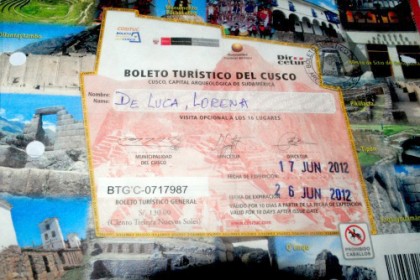
Sacred Valley and Cusco, Boleto Turístico.
Photo: mevoydeviajea.wordpress.com
The pass is about $50 and it’s good for five days to any of the sites despite the means of transportation you use to get to them.
A practical city bus (ask your hotel concierge) will take you to the sites nearest the city of Cusco.
Architecture
Of course, the sites at the Sacred Valley are not as grand as Machu Picchu. But perhaps they provide an inside look at what daily life was for the Incas.
They had very consistent specifications throughout all their buildings, for instance the stones used to form walls were not glued to one another.
They just designed them to fit together perfectly with intricate engineering methods. You can’t really see how one stone is attached to the next because they interlock inside.
You will also see water fountains everywhere. These fountains still have running water from the mountains. They were built taking advantage of the slope of the hills and they keep working today.
There are also many terraces used for harvesting food, always respecting the form of the mountains and bringing an element of aesthetic beauty to them.
If you walk the Inca Trail to Machu Picchu, you will see many more sites, than the ones I’m about to cover.
Archaeological sites of the Sacred Valley
Qoricancha
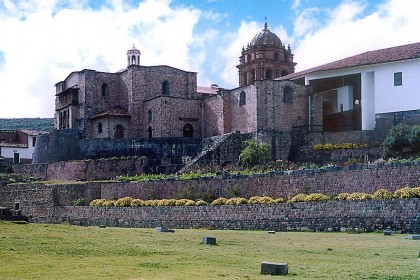
Photo: Wikipedia, Håkan Svensson (Xauxa).
Please copy and paste the following link to go to the original image:
http://en.wikipedia.org/wiki/File:Cusco_Coricancha_view1.jpg
Inside the city of Cusco there’s a cathedral called Santo Domingo, built on top of an Inca temple dedicated to the Sun God. Qoricancha is a Quechua expression meaning Temple of the Sun.
This was the most important temple of the Inca Empire and it is believed to have been covered in gold.
Today the Inca stone walls remain with their sophisticated masonry.
Saqsayhuaman

Photo: Wikipedia, Martin St-Amant (S23678).
Please copy and paste the following link to go to the original image:
http://upload.wikimedia.org/wikipedia/commons/4/48/Sacsayhuamán_Décembre_2006_-_Vue_Panoramique_-_Pleine_résolution.jpg
A complex also dedicated to the sun, Saqsayhuaman, the House of the Sun was a huge complex that used to include towers and other buildings.
It may have been used as a defensive structure as it is said to have happened during the battle with Manco Inca, a chief who laid siege to Cusco.
The plaza may have been used for ceremonial rites and it can hold thousands of people.
Today it is a touristic site, but most importantly it is the site of the Inti Raymi, the annual Inca festival of the winter solstice celebrated each June 24th.
Qenqo
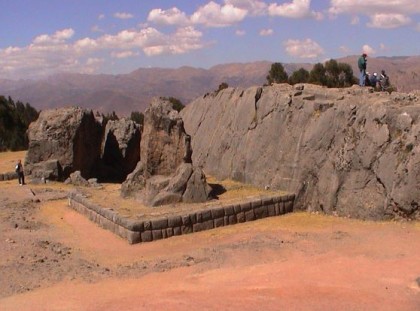
Photo: bamboobutterfly.com
This semi-circular site was called an amphitheater by the Spaniards but in actuality Qenqo may have been a sanctuary or the tomb on an important Inca.
Tambomachay
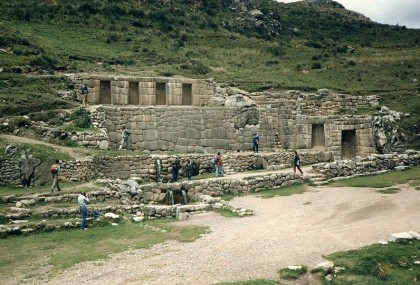
Photo: Wikipedia, Bernard Gagnon.
Please copy and paste the following link to go to the original image:
http://en.wikipedia.org/wiki/File:Tambomachay.jpg
A gorgeous site that seems to be an altar for water. With waterfalls and fountains fed by two aqueducts, it is believed that Tambomachay may have been a spa for the Inca or his maidens.
It is also believed that this open-air construction may have been roofed at one point.
You can just sit quietly and listen to the water running. It’s very peaceful.
Pukapukara
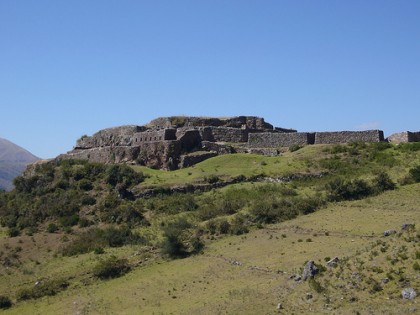
Photo: wiki.sumaqperu.com
Still near Cusco, Pukapukara may have been a food storage facility or a set of military buildings.
The name means red stone.
Tipon
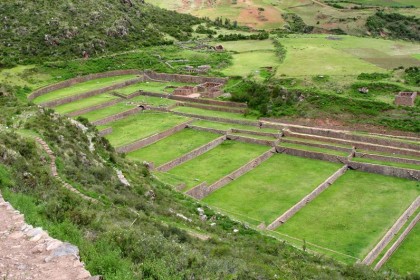
Photo: Wikipedia, Tencho.
Please copy and paste the following link to go to the original image:
http://en.wikipedia.org/wiki/File:Tiponperu.jpg
With its magnificent terraces, it is believed that Tipón was a center for agricultural research because of its water supply (still working today) and the micro-climates found in the complex.
Tipon is located 27 km (16 miles) south of Cusco.
Pikillaqta
30 km (19 miles) south of cusco, Pikillaqta is one of the most important cities of the Inca Empire with villas for the most important inhabitants. Today only ruins remain.
Pisaq
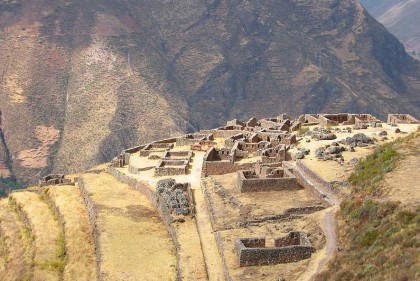
Pisaq ruins. Photo: Wikipedia.
Please copy and paste the following link to go to the original image:
http://en.wikipedia.org/wiki/File:QAllaqasa_ruins_at_Pisac,_Peru.jpg
The modern town of Pisaq is famous for its Sunday market where you can buy all kinds of beautiful crafts and fantastic Peruvian food.
But the Pisaq ruins located 33 km (20 miles) east of Cusco tell a story of superb masonry and sophisticated design, leaving anybody in awe of the greatness of the Inca Empire.
This site may have served several purposes as religious, military and agricultural center.
Chinchero
One of the Inca cities, Chinchero looks a lot like it must’ve looked in the 15th century. Perhaps the most important building is the church built upon Inca structures.
It is not unusual for inhabitants of Chinchero to come to you offering to take a picture in Quechua, they are very friendly!
Ollantaytambo
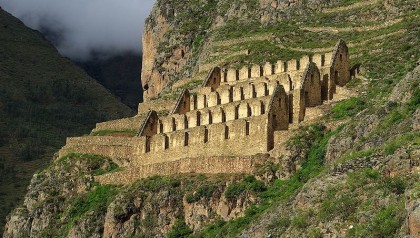
Ollantaytambo warehouses. Photo: Wikipedia, Stevage.
Please copy and paste the following link to go to the original image:
http://en.wikipedia.org/wiki/File:Ollantaytambo_granaries_Stevage.jpg
One of the most impressive of Inca cities, Ollantaytambo is located about 60 km (37 miles) north of Cusco, next to its modern namesake.
Prepare for a steep hike in Ollantaytambo to catch magnificent views and marvel at the high structures perched on the mountain across.
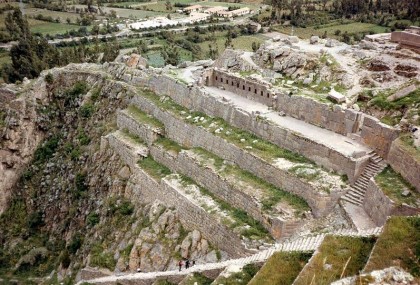
Photo: Wikipedia, Bernard Gagnon.
Please copy and paste the following link to go to the original image:
http://en.wikipedia.org/wiki/File:Ollantaytambo,_Peru.jpg
They may have been warehouses or cemeteries.
If you’re a nerd like me and are into archaeology and history, The Sacred Valley of the Incas is a must see when you visit Peru.
Have you been to the Sacred Valley? Did you know about the many fabulous sites?
Share your comments in the field below or join us in Facebook!
Practicalities
- Cusco is high. It’s about 11800 feet high. Unless you’re a professional mountain climber, you will get some mild symptoms of altitude sickness. Hotels in Cusco generally offer a beverage called “mate de coca”. (Don’t worry, it’s just an herbal tea). Accept it, it will help.
- There are no seasons in Cusco, except for a rainy season and a dry season. However because of the altitude, it is always quite chilly, like the end of autumn.
- Despite this, Machu Picchu is lower, about 9200 feet, so the temperature is much nicer.
- Cusco is completely prepared for tourist. Credit cards are accepted anywhere and dollars are exchanged in many legitimate spots. Ask your concierge.
- Do take advantage of the amazing Peruvian cuisine at the restaurants at Plaza de Armas, the main square.
- To pronounce the names, pretend the q is a k.
- Secret tip: There’s a train station at Ollantaytambo. You can arrange for your taxi driver (from the Sacred Valley tour) to pick you up there to save yourself about 2 hours of train ride back to Cusco.
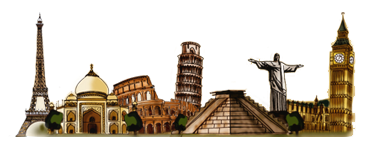
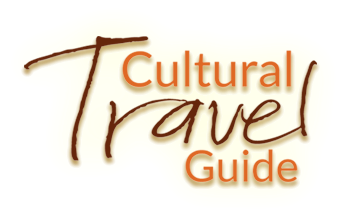

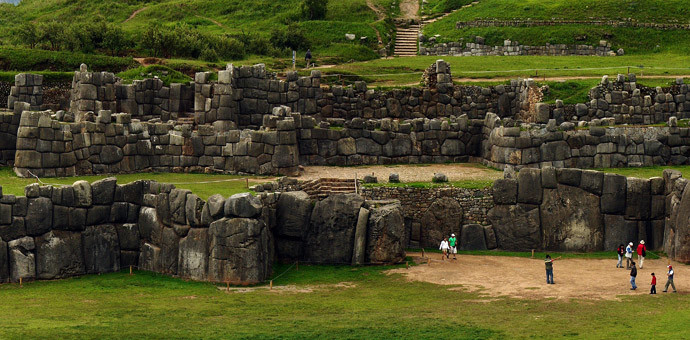
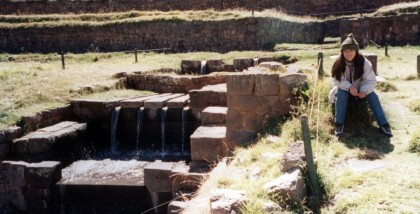
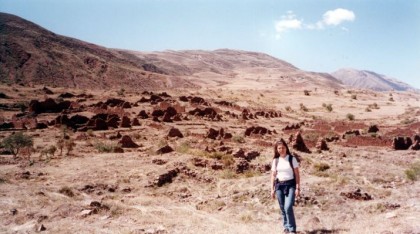
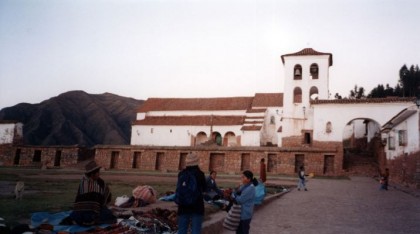
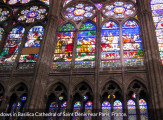
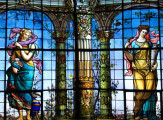
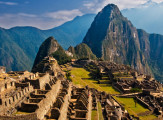
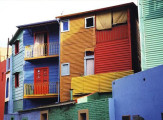
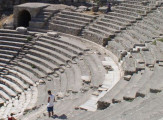
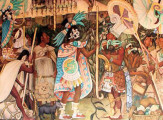
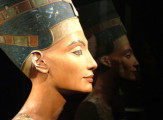
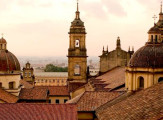
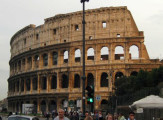
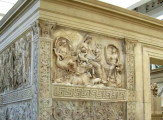


















We have 4 days to spend in the Sacred Valley. Three of those nights are in Ollaytantambo, please advise where we should spend our last night before moving on to Cuzco for another 4 days. If there are some accommodation you can recommend that would be a $$ rather than a break the bank $$$, that would be so appreciated. We tried Greenhouse in Urambambo, it’s full. Thank-you for any help.
Hi, Michelle!
Thank you for your comment! It’s fantastic that you have enough time to visit the Sacred Valley slowly and really absorb it all!
It’s hard to make recommendations without knowing your budget and your itinerary, but I would recommend you stay in Pisaq, especially if it falls on a Sunday; the local market is really lively and colorful. You can stay at the Royal Inka Hotel Pisaq.
Another option is staying in Chinchero and check the gorgeous Inca and Spanish church. You can stay at the La Casa de Barro Lodge.
You should know I haven’t personally stayed at these hotels, but I’ve gotten great comments about them. I’ve always just stayed in Cuzco as my base. I hope that helps and have a fantastic trip!
I know it has been a while since you posted this, but what should one expect a private car to cost for a whole day of Sacred Valley touring? That seems like it might be a bit expensive for the trip I’m hopeful to take but in planning I’d like to understand what it might be.
Hi, Matt! Thanks for your comment. I won’t say it’s cheap, especially since Machu Picchu was declared one of the wonders of the modern world a few years back, prices to visit it and the Sacred Valley rose.
Your hotel will have precise information about the cost of such service. For a South American location, Cusco is very well prepared for the tourist and your hotel will be able to coordinate this excursion for you. So check with them.
Right now an entire day with a personal driver can cost you anywhere from $100 to $250. Maybe a bit less, maybe a bit more. The good thing about South America is that doing business directly with locals allows you to haggle quite a bit. Now, if you can manage to partner with a couple of people in your hotel, you can split the cost. Any car can take 4 passengers comfortably.
I hope that helps and come back and let us know how it went!